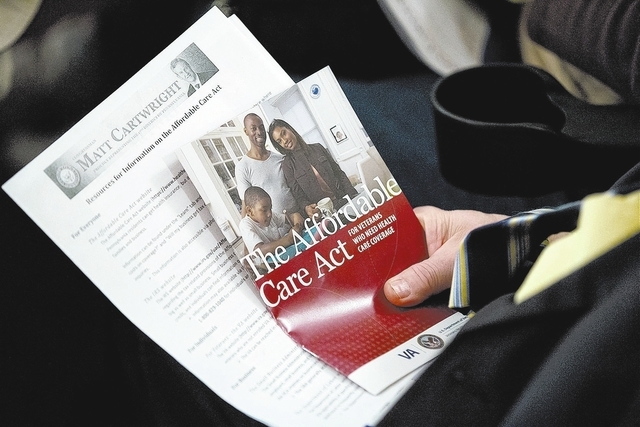As Obamacare kicks in, more small businesses may opt to go it alone
Small businesses are picking up on a big-business idea in an effort to save on health coverage.
They’re looking at self-insurance — taking over direct responsibility for paying claims — to get around some of the coverage rules in the Affordable Care Act, or Obamacare.
Self-insurance could have advantages for some companies. But local insurance brokers say it also comes with risks. And in some ways, it subverts Obamacare’s goal of getting maximum coverage for as many consumers as possible.
Insurance brokers disagree on how important self-insurance, also called self-funding, will become in Nevada. The trend hasn’t yet taken hold here the way it has in California and other states. No brokers interviewed for this story could name a local small-business client who has self-insured.
That’s because Nevada’s commercial insurance market — dominated by Health Plan of Nevada and its huge contracting clout with providers — keeps costs relatively low compared with plan expenses in other states, said Georges Maalouf, executive vice president of Brown &Brown Insurance of Nevada.
“Because Health Plan of Nevada’s model is so cost-effective, there’s really no opportunity to save money,” Maalouf said.
But Pat Casale, a broker with Patrick Casale &Associates in Las Vegas, said self-insurance is an idea whose time will come in Nevada once employer-based plans begin coming up for renewal in mid-2014 and become subject to Obamacare employer-coverage mandates. He said he has clients with as few as 15 employees asking about self-funding.
“When we come to July 1, it will get really exciting,” Casale said. “Brokers who are not looking at self-funded models are not going to be in business.”
That could be an exaggeration — or not, said Mary Beth Hartleb, CEO of Henderson human-resources consulting firm Prism Global Management Group.
“It’s always a possibility more companies will look into (self-insuring),” she said. “The whole health care system is in such a state of flux that we just don’t know. Things seem to change almost every day, and they have postponed some of the mandates. Until we find out after Jan. 1 what it really looks like, who knows?”
What is clear is that self-insurance is shaping up as a way for some smaller companies to try to save money on health care costs under Obamacare. To understand why it could pare expenses, look at how it works.
WHY SELF-INSURE?
If you self-insure, you pay employees’ medical costs directly, as they happen, rather than paying a monthly, fixed premium to an insurance carrier to pay claims. To fund claims, you open a trust fund for monthly premium contributions from the company and employees. To administer your self-funded plan, you hire an employee benefits firm or an insurer.
Self-insuring is already popular with big businesses. Twenty-four percent of Nevadans are covered through self-insured plans, according to March numbers from the state Division of Insurance. But Maalouf estimated that 90 percent of companies with 5,000 or more employees, such as big hotel-casinos, are self-funded.
The advantages start with lower expenses. Because you pay claims yourself, you save on some of the administrative markups that third-party insurers charge to cover their costs. You also get more control over your health benefits, from crafting a plan specifically for your employees’ needs to directing your claims fund for the highest investment returns.
Then there are the tax and fiscal savings. Companies don’t have to pay premium taxes or annual insurance fees on self-insured plans, Maalouf said. That can save an employer as much as 3 percent of the premium’s dollar value, according to the Self Insurance Institute of America.
But the biggest advantage of self-funding — and the reason more small companies are looking at it, Casale said — is that the plans are exempt from many Obamacare mandates, such as coverage for mental health and maternity care. That’s because self-insured coverage is regulated under a separate federal law, the Employee Retirement Income Security Act.
That also means self-insured plans can avoid Obamacare’s age-rating rules. The law limits the premium difference insurers can charge between young, healthy people and older, sicker members, so costs for healthier consumers have soared as carriers try to close the gap. Because self-funded plans don’t have to follow those regulations, they can recapture pricing benefits if their employees are mostly younger and healthier, or don’t see the doctor very often, Casale said.
That’s why “the perfect target market” for self-insurance will be companies that mostly hire young, healthy males, Casale said. Think plumbing and electrical contractors, for example.
So far, brokers say few local small companies have looked into self-insurance. Hartleb said she’s seen a “bit of an uptick” in inquiries but no serious marketwide movement toward self-funding.
That might be because self-insurance can bring big trouble to small businesses if things don’t work out.
THE DOWNSIDE
The deepest potential pitfall in covering employees’ health claims directly is that, well, you’re covering employees’ health claims directly. It’s not a problem if your workers stay well, but one stage 4 cancer diagnosis or car accident with head trauma in a group of 15 workers could be catastrophic, especially if you don’t have the cash flow to cover the additional costs.
“There’s so much risk for a small business to go that route. You’re basically responsible for all of the claims,” Hartleb said.
And because a small company has a relatively small sample group, health costs can be unpredictable, Maalouf said. With 10,000 staffers, you get a feel for what your expenses might look like year to year, but a couple dozen workers mean claims could vary widely over time.
“You could have one significant claim that could really skew the claim experience for the group,” he said.
Plus, it’s just easier to cover unexpected major illnesses when you have thousands of colleagues to help defray the cost.
Said Frank Nolimal, an employee benefits adviser at Assurance Ltd.: “I personally am very concerned about many companies going to this model because of the spread of risk. It is very difficult for a small company in the 20s, 30s or 40s to go to self-insurance, and I believe the risk will outweigh the possible gain or savings they will ever see.”
Stop-loss insurance can help by kicking in on claims exceeding a certain amount — say, $25,000. Still, Maalouf said he doesn’t think “most small companies want to be in the business of managing risk through a health plan.” Of his more than 600 commercial clients, not one has gone through with self-funding, he said.
Managers also should be careful because some so-called self-insurance products on the market are really just variations on high-deductible plans, Maalouf said. Those policies may not come with stop-loss insurance or the plan structures that self-funded plans typically offer.
Then there’s the larger issue of getting around the Affordable Care Act. It might make sense for an employer to look for ways to opt out, but that means fewer consumers will have access to the essential health benefits that the law’s advocates say they want to spread to as many people as possible.
As healthier workforces find workarounds, plans and insurance marketplaces subject to the law could see spiraling expenses as they cater more to sicker, older members.
But Casale said he believes businesses will be in the market for just such workarounds, and self-insurance is something increasing numbers of companies will weigh.
“It’s an additional way for them to screen and figure out ways around the rules to make sure they can get people affordable coverage,” he said.
Contact reporter Jennifer Robison at jrobison@reviewjournal.com. Follow @J_Robison1 on Twitter.




























